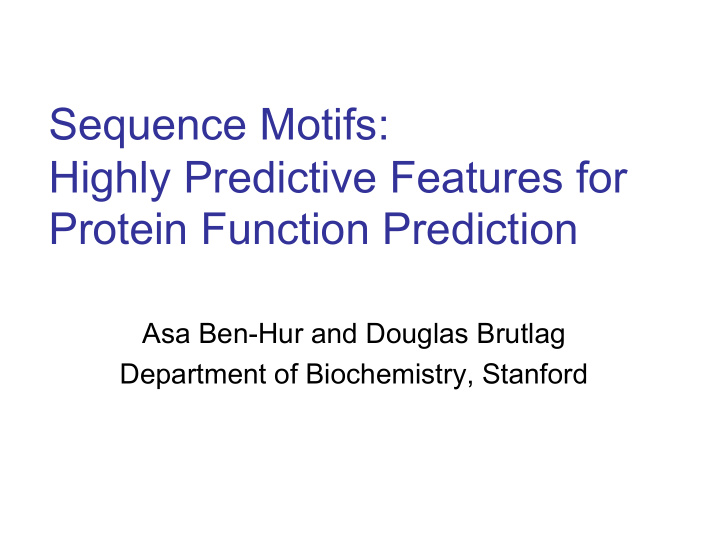



Sequence Motifs: Highly Predictive Features for Protein Function Prediction Asa Ben-Hur and Douglas Brutlag Department of Biochemistry, Stanford
Background � Proteins participate in most of the biochemical processes in the cell � SwissProt: Protein sequence database. Contains ~140K sequences � Enzymes: facilitate chemical reactions � Enzyme Commission (EC) numbers: n1.n2.n3.n4 � SwissProt contains 35K enzymes which belong to ~750 EC classes
Similarity / Representation � Similarity: � Weighted edit distance: Smith-Waterman and BLAST methods � Model-based, e.g. HMM (Haussler et al.) � Fisher kernels (Jaakkola et al.) � Vector-space representation: � Extract a set of properties (amino acid counts etc.) � Represent a sequence in the space of all 20 k k-mers (spectrum and mismatch kernels, Leslie et al.) � Motif composition
Protein Sequence Motifs Snippet of a Multiple sequence alignment � Evolutionarily conserved sequence elements � Represented as regular expressions or as position- specific scoring matrices � Known to be part of protein functional sites: Motifs : � Catalytic sites � Binding sites substitution wildcards group Syntax : amino k[ilmv]…hq acid
Computing Motif Composition Represent motif database in a TRIE with motifs in leaf nodes
The Motif Representation � A “bag of motifs” representation of a protein sequence: Motif Database Motif Count � A high dimensional feature vector: motif database can contain several hundred thousand motifs The motif kernel is a linear kernel that essentially counts the number of motifs two sequences have in common
Assessing Motifs as Features For each class of enzymes we compute a statistic for each feature:
Feature Selection Results � Feature selection using the L 0 (multiplicative update) method of Weston et al. compared with SVM trained on all features: # features for each class Balanced Success Rate:
Classification Results � KNN works very well: � Success rate on all data: 0.94 (same as SVM) � One-against-rest comparison with SVM: Area under ROC50 curve Balanced Success Rate
Conclusion � Motifs: highly discriminative features for predicting the function of a protein � Can provide low dimensional, interpretable classifiers � Domain knowledge required Things I haven’t mentioned: � Discrete motifs vs. scoring matrices � Custom motif databases for enzyme classification
Recommend
More recommend